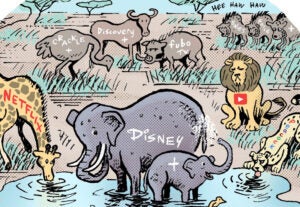“Data Driven Thinking” is written by members of the media community and containing fresh ideas on the digital revolution in media.
Today’s column is written by Marc Schwartz, who is EVP, Global Director of Performance Analytics at McCann Worldgroup.
Advertising has always been about change. Evolving communication technologies are the most recent drivers of this change. These new technologies, mostly digital, are generating data as never before. For ad agencies, this provides many new opportunities in an area of the business where they least expected to benefit from more data — the creative process.
The key to this opportunity is for agencies to recognize how today’s data is different from their familiar associations with it. It is not about static information, but it offers real-time indicators of the mind of the consumer. As such, embracing data is consistent with how agencies have always sought to understand consumers better through market research and other insight tools.
However, in order for agencies to evolve a greater appreciation of these new information sources, they need to stop thinking about “data” as technologically specialized information. Data is not the enemy of creativity. When applied correctly and meaningfully, it in fact expands how agencies have traditionally understood and integrated consumer information — generating new insight and creative opportunities.
Bringing data into the heart of creative solutions will allow for advertising that can become more relevant because it can meet consumers where they are living. The types of data we have today can stimulate new levels of customization based on consumer needs. This highly targeted approach to using data has generally been associated with the growth of more technology-based marketing approaches, such as CRM. But so-called “traditional” advertising can now benefit as well, with creative approaches that are integrated, holistic, and organic.
The most recent IKEA catalog highlights an accompanying digital offering — an app with extended content that is fueled by geography and personally scanned information. This allows consumers to participate in a dialog as opposed to one-directional marketing, creating a level of engagement that can grow and evolve as the consumer responds. For IKEA, this means that their initial creative work is only the beginning of the consumer engagement. As they attempt to connect creative, technology and data, they can seek to continuously add value to the customer experience.
Strategic thinkers at creative agencies need to become better at communicating the power of data to creative people in ways that they can appreciate and utilize. The current disconnect is not intentional; it merely reflects the challenge to integrating right and left-brain thinking. We all share the same goals of creating solutions that increase relevance for consumers. We therefore need to bridge the divide between strategy and creativity by demonstrating that the power of data can add value. It can take the creative and brand agency to a new place by connecting solutions to more effective results.
To accomplish this, we need to convey the value of data in new ways. It is not just about more information, but about new insights into how people are thinking and acting, socially and as consumers.
- Data can be a tool to fuel inspiration in the creative process. Connecting brand, behavioral, transactional, social conversation and attitudinal data will give a view of the canvas on which the creative will be playing. Understanding where brands are playing in social conversation, for example, can identify white spaces in the hearts of their consumer. It can reveal where passion points can become places of intersection with the brand, introducing more relevant places to connect. This information can focus a creative solution on what is pertinent now, an advantage over research from last year’s brand tracker. This will not only provide creative insight, but also identify potential KPI’s that can be used to measure the impact of the creative solution.
- Data can act as a platform for new types of storytelling. The dynamic nature of social media and participation marketing can take a brand narrative and personalize it through the triggered actions and activities of a customer. This can take brand conversations to a new level. With interpretation and application, meaningless data can become consumable and actionable. It can create more stories and take the inundation of data sources and make sense of them, fueling the discovery of future-impacting insight.
- Data can be an asset and driver for creative solutions. Data upfront can be the raw material fused to inform or power creativity. The data you can identify and use has the power to illuminate and guide the creative output. Imagine developing solutions like Nike Plus. Having a data feature in your shoes that “track every move on the court” and then sync with your phone to account for your progress gives Nike the ability to create relevant CRM, mobile, and other communications.
The successful history of agencies is marked by continuous evolution. When agencies adapted to mass media such as radio and television, they not only had to adapt to new creative formats but to entirely new ways of understanding how consumers thought, reacted, and behaved — and to new measurement approaches. They must now also begin to think differently about capabilities that are seen as siloes or as specialty parts of the agency. This includes data and analytics, which are no longer back-office functions, relegated to technical measurements or behind the scenes optimization.
At general ad agencies, we still have two fundamental tasks: (1) We have to create breakthrough work that will be noticed; and (2) We have to create work that provides shareable value. In this evolving consumer and brand landscape, this cannot be done without looking at the world in a new way. Data, in the hands of smart creative and strategic people can be inputs that drive creativity to a new level.
Follow Marc Schwartz (@mas4462) and AdExchanger (@adexchanger) on Twitter.














